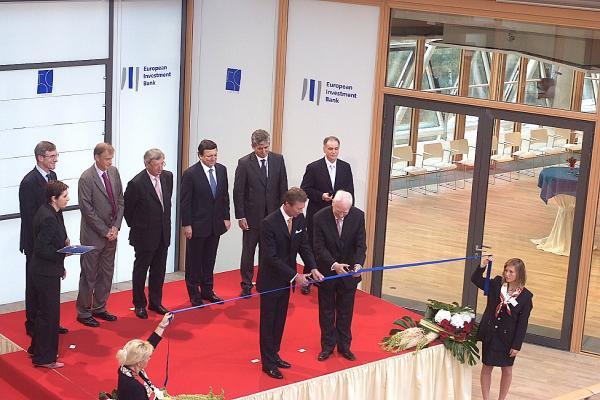
Today, 2 June 2008, the European Investment Bank (EIB) inaugurated its new building on a site next to its existing headquarters on the Kirchberg plateau in Luxembourg. Both restrained and innovative, and designed entirely with environmental considerations in mind, this building substantially increases the work space of the EIB, the EU’s financing institution, enabling it to accommodate the whole of its staff on a single campus.
The opening ceremony was graced by the presence of H.R.H the Grand Duke of Luxembourg, along with the Governors of the EIB, the EU’s Finance Ministers. Speakers included Jean-Claude Juncker, Prime Minister and Finance Minister of the Grand Duchy of Luxembourg, José Manuel Barroso, President of the European Commission, and Andrej Bajuk, Slovenia’s Finance Minister and current President of the Economic and Financial Affairs Council, who together described the EIB’s ever-growing role in the process of European integration, highlighting the importance of its action to promote European projects and congratulating it on this architectural achievement.
In his address, EIB President Philippe Maystadt briefly enumerated the milestones in the institution’s history since its creation in 1958. He looked back on its establishment in the Place de Metz in Luxembourg in 1968, then the move in 1980 to its current headquarters in Kirchberg in a “modern” and “solidly constructed” building. Along with these still relevant criteria the President stressed the importance of “transparency” and “respect for the environment”. He recalled that the brief given to participants in the architects-designers competition at the launch of the new building project was to deliver a building that was unostentatious, functional, transparent and environmentally friendly, going on to say: “Now, what could characterise the EIB better as it celebrates its 50th anniversary than the combination of solidity symbolised by the West Building and the transparency of the East Building, along with the constant attention to environmental considerations?”
A building for the future
Environmental and energy concerns were key to the design of the building by the architect Christoph Ingenhoven (Düsseldorf) and its construction by CFE-Vinci (Brussels, Paris).
The glass shell enveloping the whole building makes maximum use of natural light. Winter gardens and atria provide thermal insulation and natural ventilation, keeping energy consumption and emissions to a minimum. The building complies with the most stringent environmental standards, even exceeding legal requirements. It is the first building in continental Europe and one of the first in the world to be awarded the UK’s BREEAM Bespoke “high environmental quality” certification with the rating “very good”.
In this way the building reflects the priorities of the EIB, which earmarks a substantial part of its lending for projects aimed at improving or protecting the environment and especially provides backing for projects that help to combat global warming.
The EIB’s new East Building is located at 98 boulevard Konrad Adenauer. Backing on to the “Bons Malades” valley, it forms a continuum with the Bank’s existing headquarters in the “North European District” of Kirchberg in Luxembourg. With its 72 500 m² of work space it can house up to 750 staff.
This ceremony marks the end of a three-year project drawing on the experience and know-how of 238 companies partnering the EIB, including first and foremost: Ingenhoven Architekten (Düsseldorf), Olivi & Rodrigues (Luxembourg), Soludec (Luxembourg), CFE-Vinci (Belgium/France), Jacobs France-Paul Wurth (France/Luxembourg) and Secolux (Luxembourg).
For further information about the building:
Photographer: EIB ©EIB
Download original

Photographer: EIB ©EIB
Download original

Photographer: EIB ©EIB
Download original

Photographer: EIB ©EIB
Download original

Photographer: EIB ©EIB
Download original

Photographer: EIB ©EIB
Download original

Photographer: EIB ©EIB
Download original

Photographer: EIB ©EIB
Download original

Photographer: EIB ©EIB
Download original